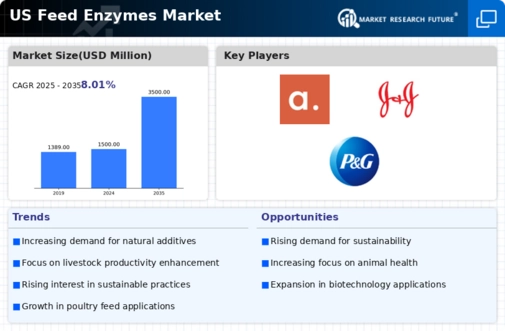The feed enzymes market is characterized by a dynamic competitive landscape, driven by increasing demand for animal protein and the need for sustainable agricultural practices. Key players such as Novozymes (Denmark), BASF (Germany), and DuPont (US) are at the forefront, leveraging innovation and strategic partnerships to enhance their market positions. Novozymes (Denmark) focuses on developing enzyme solutions that improve feed efficiency and reduce environmental impact, while BASF (Germany) emphasizes its commitment to sustainability through the introduction of new enzyme products that align with eco-friendly practices. DuPont (US) is actively pursuing digital transformation initiatives to optimize its product offerings and enhance customer engagement, thereby shaping a competitive environment that prioritizes innovation and sustainability.
In terms of business tactics, companies are increasingly localizing manufacturing and optimizing supply chains to enhance operational efficiency. The market structure appears moderately fragmented, with several key players exerting considerable influence. This fragmentation allows for a diverse range of products and solutions, catering to various segments within the feed enzymes market. The collective strategies of these companies contribute to a competitive atmosphere where innovation and sustainability are paramount.
In November 2025, Novozymes (Denmark) announced a strategic partnership with a leading agricultural technology firm to co-develop enzyme solutions aimed at improving feed conversion ratios in livestock. This collaboration is expected to enhance Novozymes' product portfolio and strengthen its position in the market by addressing the growing demand for efficient feed solutions. The partnership underscores the importance of innovation in meeting the evolving needs of the agricultural sector.
In October 2025, BASF (Germany) launched a new line of feed enzymes designed to optimize nutrient absorption in poultry. This product introduction is significant as it aligns with the company's sustainability goals, potentially reducing feed waste and improving overall animal health. By focusing on nutrient efficiency, BASF is likely to enhance its competitive edge in a market increasingly driven by environmental considerations.
In September 2025, DuPont (US) unveiled a digital platform that integrates AI-driven analytics to provide real-time insights into feed enzyme performance. This initiative is crucial as it positions DuPont at the intersection of technology and agriculture, enabling customers to make data-driven decisions that enhance feed efficiency. The integration of AI into product offerings may redefine competitive dynamics, as companies that leverage technology effectively could gain substantial market advantages.
As of December 2025, current trends in the feed enzymes market indicate a strong shift towards digitalization, sustainability, and AI integration. Strategic alliances are increasingly shaping the competitive landscape, fostering innovation and collaboration among key players. Looking ahead, competitive differentiation is likely to evolve, with a pronounced shift from price-based competition to a focus on innovation, technology, and supply chain reliability. Companies that can effectively navigate these trends will be well-positioned to thrive in an increasingly complex market.














Leave a Comment